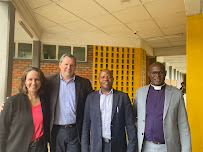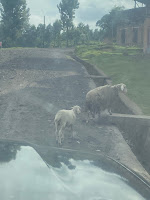Out of the City (Post #6)
On March 28, I checked out of the hotel and started my journey out of Kigali to Musanze, a 70 km drive up the mountain. My driver, Keba, (more on him later) picked me and Linda up and we wound our way out of the bustling city. They urged me to sit in front to see all the sights, and I am so glad they did. There was something beautiful and interesting to look at every moment.

The houses are perched on every hillside around the road, mixing commercial and residential areas all together.
Then as we got further from the city, every inch of land was cultivated with crops in small gardens. There is no untouched space, all the land is being used to produce food in some way.
The thing that fascinated me the most was watching the people travel up and down the mountain road. It is a paved road, one lane each way, and all the traffic goes on this one path. Big trucks carrying anything from cases of beer, rocks, cows, or scrap metal go in and out of the city. Range Rovers carrying tourists going to trek in the west, motor cycles taxying people who can afford a lift, and a few pick ups taking large loads of vegetables to market all share this way. But right along side them, people walk or push bicycles up the mountain with huge loads. Everything from sugar cane to tables to sacks of maize go up and down this one road.
I could not believe the strength and persistence of each of these people.
The road wound in switchbacks uphill and we finally came to a bend where you can look back on the Kigali skyline. This view really helped me understand how big Kigali is getting. It is a place that wants to burst with progress in a country of green hills.
 We also passed a number of local vegetable markets. Here you can see large packs of maize and sweet potatoes, bagged and ready for market. People pack these huge bags and carry them up to 3 at a time on a bicycle, up the hills to market. But this is what will pay to feed their families, so they go.
We also passed a number of local vegetable markets. Here you can see large packs of maize and sweet potatoes, bagged and ready for market. People pack these huge bags and carry them up to 3 at a time on a bicycle, up the hills to market. But this is what will pay to feed their families, so they go.Mid way between Kigali and Musanze, there is a rest stop called Nyirangarama. It is a roadside collection of restrooms, a shop that sells food and baked goods, and a grill that makes ready to eat snacks. The place is run by a local man who supports his community in many ways. He hires local young people and then pays their tuition so they can stay in school when they are not working for him. Amazing community building!
When we got there, many busses full of teenagers on school holiday trips were pouring into the rest stop. Seems like everyone always stops here.
 We stopped in for a break and a snack. Keba ordered us some brochettes and fried potatoes. I have to say, the potato was so delicious I have been dreaming about it since, and I made him stop on the way back out of Kigali at the end of my trip just to grab two more! It was just a full potato deep fried so the outside was super crispy and the inside was like melted gold. Yum!
We stopped in for a break and a snack. Keba ordered us some brochettes and fried potatoes. I have to say, the potato was so delicious I have been dreaming about it since, and I made him stop on the way back out of Kigali at the end of my trip just to grab two more! It was just a full potato deep fried so the outside was super crispy and the inside was like melted gold. Yum!Linda was still along for the ride to make sure I got to Musanze and the IREME team safely. She helped show me all the things we passed. But my new guide was Keba, the driver we found to give us transportation for the week. His English is wonderful and he told me he learned it by watching YouTube! He is an incredibly hard worker, with plans to save money and build himself his own house and business. He is a great guide, with tons of information about the whole country and fun stories at every turn. He ended up being a great friend by the end of the week and I will definitely be using him for everyone we send to Rwanda.
After the rest stop, it was more driving through gorgeous countryside.
Eucalyptus groves and waterfalls lined the way.
And then, we were in Musanze.
Musanze is the second largest city, at this point, and is growing by the minute. It is a collection of construction sites, putting up new buildings, restaurants, hotels, and shops so more people can come to this new hub. This area is close to where the tourists go gorilla trekking in the Volcanoes National Park, so there is reason to have growing commercial space here. You can see trucks bringing things in and out constantly.
There are 5 peaks altogether that form part of the borders between Rwanda, Uganda and the Democratic Republic of Congo. The first here is Mount Muhabura.
Seeing them made me realize I was getting close to my destination.
But first we had to make a stop to meet with Dr. Cash, the representative from Samaritan's Feet. This is an organization that is bringing innovative shoes to African populations without them. We are partnering with them for a shoe distribution later this month, so I went to meet them and Bishop Aphrodis, a Rwandan helping with distribution logistics.
Then finally, we neared the community where I was going and we started to see packs of children. They all waved to us and smiled and my heart leaped at the prospect that these were finally the children with whom I came to work. These are the faces of Nyabirehe Primary School.
We had a great first meeting in person to put the work part of my trip into gear. Hopefully this will grow into a bigger partnership as both our organizations grow in the region.
After that meeting, we continued up the hill even more and finally came to a crossroads. We turned off the paved road onto a road of dirt and rock, so bumpy that we went about 5 miles per hour, even in our 4 wheel drive vehicle. I did not understand until traveling myself, how tough the transportation issues are in this area. Where there are paved roads, the going is decent, but that is only one main path. Anywhere off the main road is reached by very rudimentary roads where most people are walking or traveling by motorbike taxi. Bicycles are used, but more to carry loads than ride quickly. As we started up the side road, Keba turned to me and said, "OK! This road is what we call African massage. Hold on!"
Then you have to be careful of traffic of all kinds. Mostly sheep and a few cows cross the road. These are usually shepherded by small children between the ages of 6 and 10. They roam free and the children move them with nothing more than a stick!
Then finally, we neared the community where I was going and we started to see packs of children. They all waved to us and smiled and my heart leaped at the prospect that these were finally the children with whom I came to work. These are the faces of Nyabirehe Primary School.


































Comments
Post a Comment